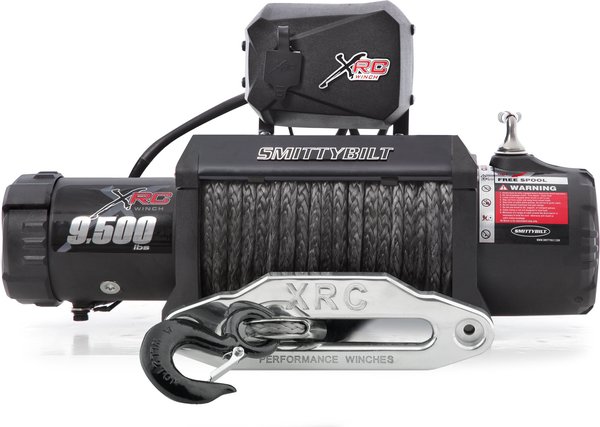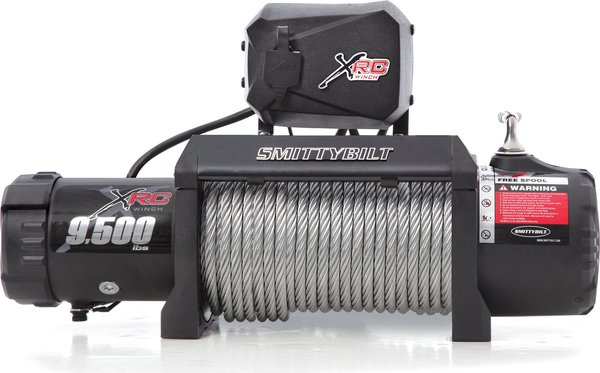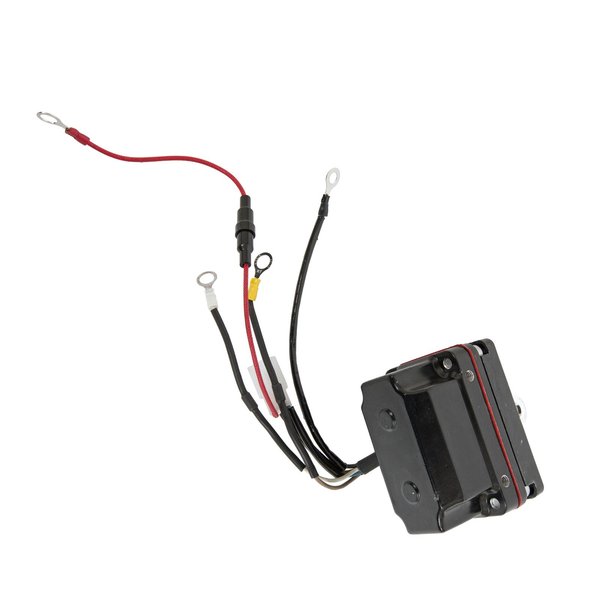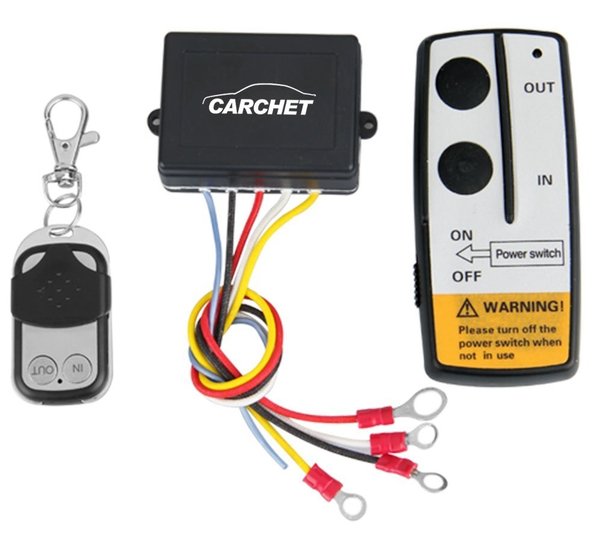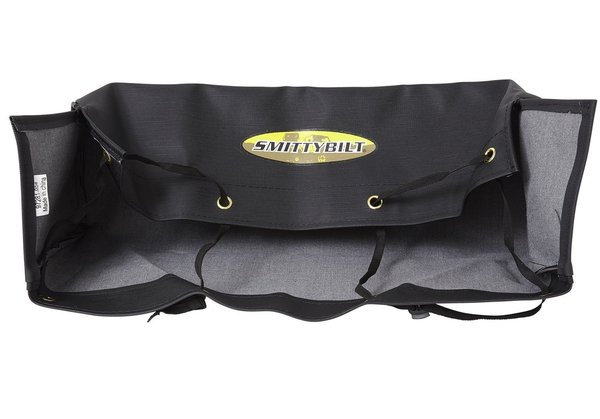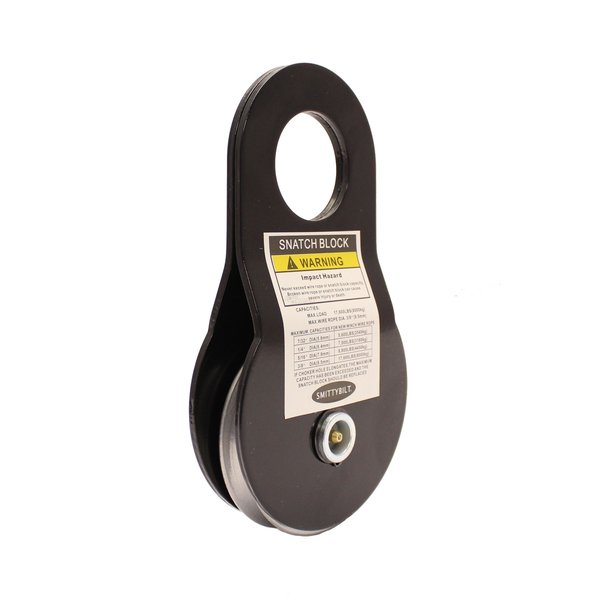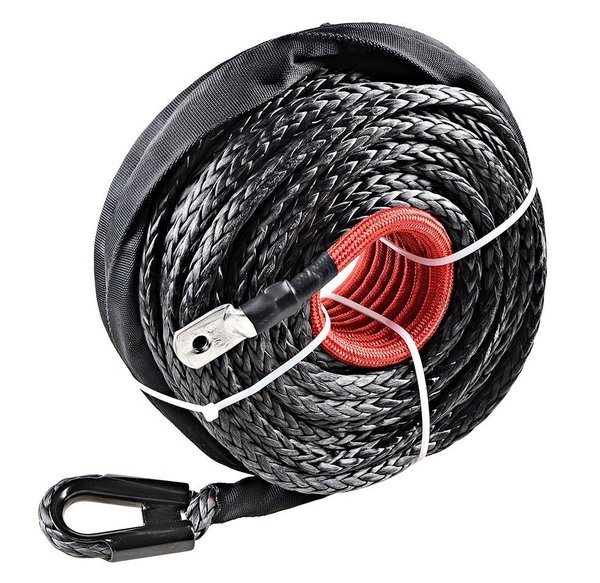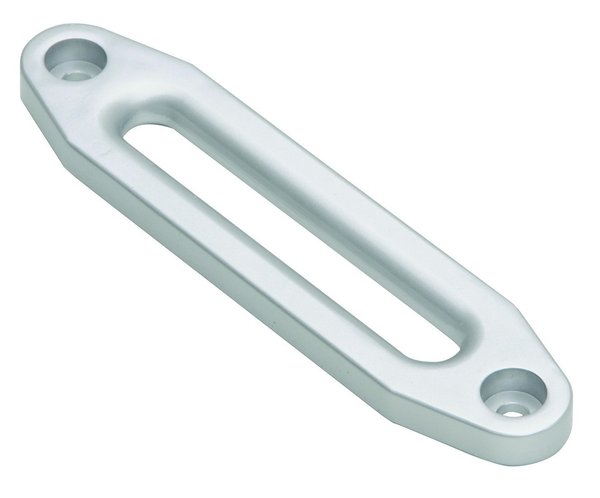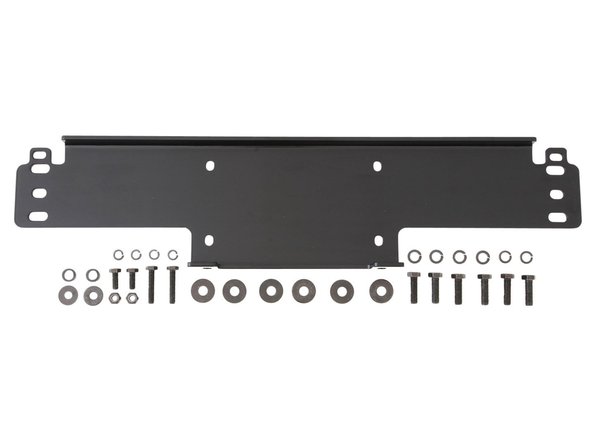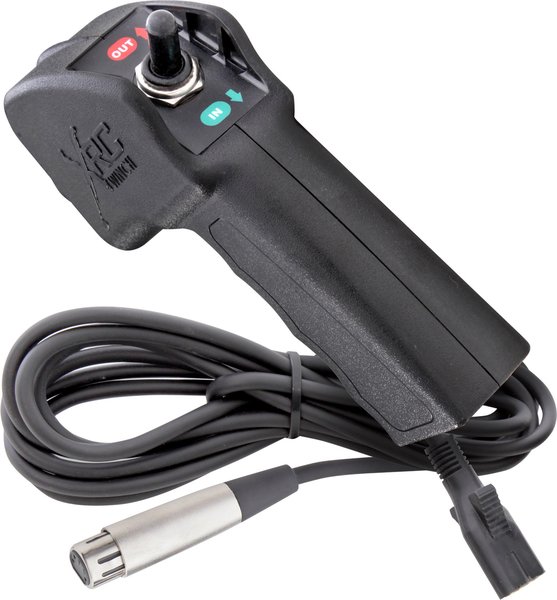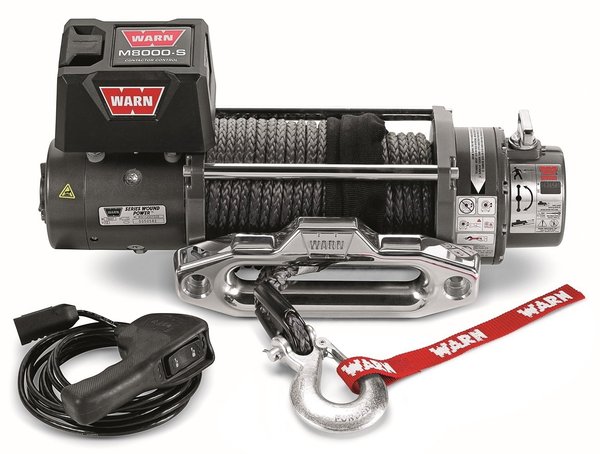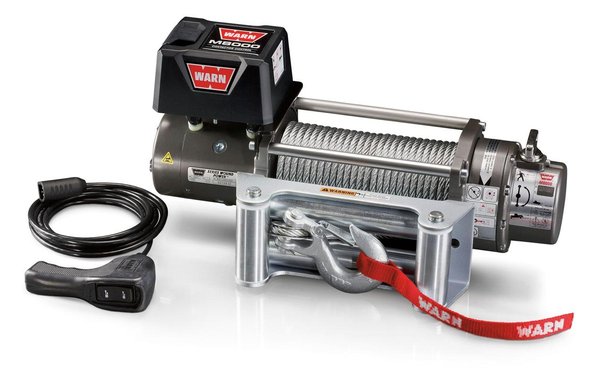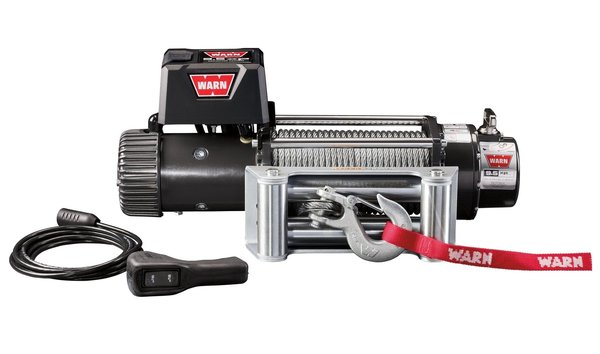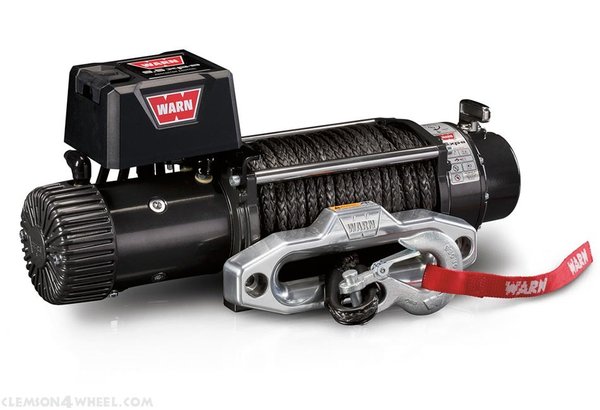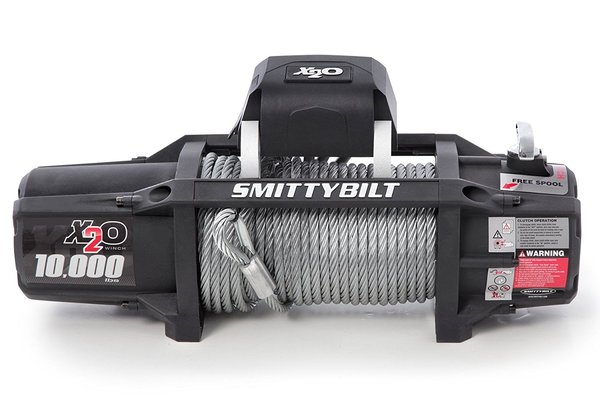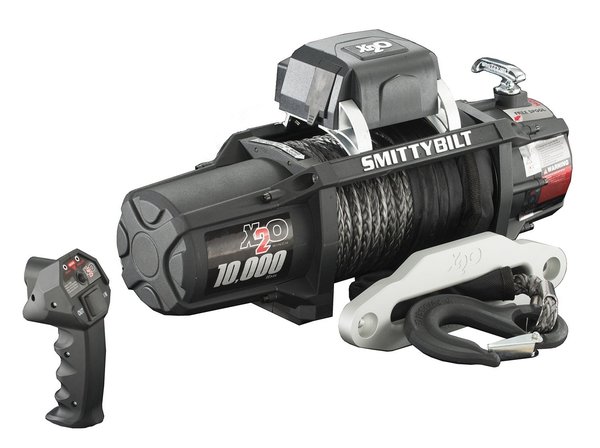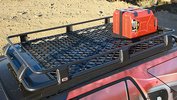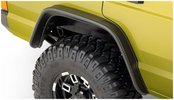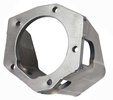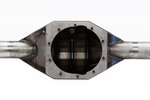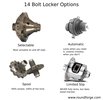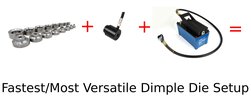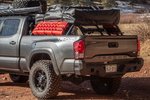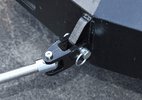Smittybilt XRC 9500 Winch Buyer's Guide
We're not all rich, driving around in Mercedes 4x4s with diamond-studded rims. Some of us actually have to budget for bigger purchases and make sure we remember to save money for food:
It can't all go into the 4x4!
But if you're stepping up your fourwheeling game and tackling tougher trails, you know you need a winch. And it has to be cheap.
Look no further than the Smittybilt XRC 9500 winch.
It might make a few compromises to hit the price point you want, but if you take care of it, it can serve you well in your off road adventures.
- A Great Budget Winch (The Basics)
- Is the 9500 XRC enough winch for your 4x4?
- Models and Part Numbers
- 9500 XRC: Steel Winch Cable or Synthetic Winch Rope?
- Performance Specs
- Smittybilt 9500 XRC Motor and Electrical Draw
- XRC 9500 Solenoids
- Is the Smittybilt XRC 9500 waterproof?
- Smittybilt XRC 9500 Upgrades
- Smittybilt XRC 9500 Installation and Manual
- Smittybilt XRC 9500 Wiring Diagrams
- 9500 XRC Replacement Parts
- Smittybilt 9500 XRC vs Warn M8000
- Smittybilt 9500 XRC vs Warn 9.5 XP
- Smittybilt 9500 XRC vs Smittybilt X20
- Smittybilt Gen2 XRC 9500 Winch 97495: Full Specs and Data
- Smittybilt Gen2 X2O COMP 10000 Waterproof Winch 98510: Full Specs and Data
- "Amphibious" motor: Keeps dry in the wet.
- Steel or synthetic winch line for any wheeling environment.
- Waterproof IP67 rating: It's waterproof to a point - more on this below.
- Uses standard solenoids for the control box.
- Has a wired winch remote.
- Quoted weights are 78 lbs for steel cable and 46 lbs for synthetic winch line - but read more on this below.
- Winch line length is 94 feet.
- The winch
- A wired winch remote
- A 5/16" x 95 ft steel winch cable or a 3/8" x 95 ft synthetic winch rope
- A steel roller fairlead or an aluminum hawse fairlead
- 72" battery cables
- Mounting hardware
- A winch cover (below in upgrades)
- A winch mounting plate (below in installation)
- An awesome battery (You're on your own)
- Stronger than steel for a given size (This is huge!)
- Light and easy to handle
- No steel splinters and burrs
- Not as abrasion-resistant as steel (sometimes you need a winch line cover)
- Breaks down with UV light exposure ( a winch cover is a good idea)
- Doubles your line pull: That 7,086 lbs suddenly becomes about 14,000 lbs, minus a little for inefficiencies.
- Redirects your winch line: Helpful when you need to winch a buddy but a tree, rock, or mudhole prevents you from getting in line with him.
- Flat over the winch motor
- Flat over the drum
- Standing up over the drum
- Winch Cable - The XRC 9500 uses 95' of 5/16". You might be able to fit on some more cable, but you don't want to crowd the drum.
- Synthetic Winch Rope - This is not the factory cable, which is very expensive. You're looking for 95' x 3/8".
- Solenoid Pack - This might go bad and needs to be replaced as a unit.
- Winch Remote Controller - This is the correct remote to work with the Gen 2 XRC winches.
- Rated line pull: 9,500 lbs.
- Steel cable or synthetic winch line: 95 feet for the XRC and 100 feet for the XP
- Motor horsepower: 6.6 for the XRC and 6 for the XP
- The full load line speeds are similar and the no-load line speed is slightly higher in the XP.
- Like the M8000, the XP uses a contactor assembly instead of a solenoid pack, making it run cooler and more reliably. Plus, it's waterproof.
- The biggest difference: the weight.
A Great Budget Winch (The Basics)
If you want the XRC 9500 winch with synthetic winch rope, this is the one to get. If you're thinking of upgrading to synthetic in the future, it's much cheaper to buy this version of the winch than to upgrade with Smittybilt parts later.
Are you the only guy in your fourwheeling group without a winch?
Are you trying to go a little further on trails while still being able to self-recover?
Are you on a budget?
Keep reading:
As you might have guessed from the name, the 9500 XRC winch from Smittybilt is rated for 9500 lbs. It's an incredibly popular winch - the price is low and it holds up so well to off road rigors. It doesn't quite have all the features of some comparable winches, but those other winches aren't as cheap.
So let's take a quick tour of it's features:
When you buy this winch, you get:
It does not include (It is a supercheap winch, you know):
There is a steel cable version that is heavier:
And a synthetic winch rope version that is lighter (though not quite as light as Smittybilt says):
When you get it
Make sure you check for all the pieces and that nothing is broken. It sounds like there have been some "packaging failures" where the solenoid box cracks or stuff is missing from inside the box.
So, check everything on receiving the winch. If you're missing stuff, contact the retailer first, not Smittybilt.
9500 XRC Winch Warranty: Backed by Smittybilt
The warranty on this winch is pretty darn good:
The mechanical warranty is Lifetime.
The electrical warranty is 3 years.
Make sure you save your receipt!
Is the 9500 XRC enough winch for your 4x4?
The 9500 XRC is a super-cheap, IP67 waterproof-rated winch that is made in China. It has a max line pull of 9,500 lbs with 1 layer of winch cable on the drum.
Okay, first things first:
The XRC is a 9500 lb winch. This means that in a single line pull, it can pull 9,500 lbs. That does not mean it's okay for just any rig.
The recommended formula for calculating how large a winch you need is to multiply your GVWR by 1.5. So, if you have a Tacoma with a GVWR of 5500 lbs the calculation looks like this:
5500 x 1.5 = 8250
That means that you need a winch that is rated for at least 8,250 lbs. We also have a simple calculator to tell you what size winch you need.
Working backwards, we can determine that the maximum GVWR that will work with this winch is 6,300 lbs.
So what if you don't know your GVWR?
You can find it. We don't recommend looking online for your GVWR. We haven't found a reliable site for GVWRs, and most sites are covered with ads to buy cars or insurance with no actual information. Online only works if you have a recent model and the manufacturer lists the GVWR./
So, here's what you do:
Go out to your rig and open the driver door. There should be a tag on the door jamb that lists a bunch of information. One of these things will be the GVWR. That's it.
"So", you ask, "is this 1.5 factor enough?"
If you have an extremely heavy rig and you think you're exceeding the GVWR, you should go up a winch size. With tires, winches, bumpers, sliders, passengers, camping gear, fuel, tools, and spares, lots of 4x4s are over the GVWR (By the way, this will earn you a ticket if you ever get weighed and your overweight).
Models and Part Numbers
There are a few different winches that are all in the 9500 XRC line - that is, XRC winches that are rated at 9500 lbs. The two winches that we are referring to in this article are the 97495 (the steel winch line version) and the 98495 (the synthetic winch rope version). These are both the Gen 2 XRC 9500. The Gen 1 winches had permanent magnet motors with 1.1 less horsepower, slower linespeed, more weight, and no IP67 rating.
The 97495 and the 98495 both share all their parts - they only differ in the winch cable and fairlead.
9500 XRC: Steel Winch Cable or Synthetic Winch Rope?
The XRC comes with either steel winch line or synthetic rope. At 78 lbs, the steel winch line version is right in the ball park of where it should be. The aluminum-drummed, steel cable Warn M8000 winch, for instance, is 74 lbs.
Why do we care? Light weights are good - it's easier to mount, and keeps the weight down on the front of your rig. However, light weights also mean thinner castings, narrower bearings, smaller shafts, and that sort of thing. Basically, it's the opposite of what you want in your 4x4's winch.
We see the main benefits of synthetic winch line like this:
The 3/8" synthetic winch rope has more than twice the breaking strength of the 5/16" steel winch cable!
But it has its downsides:
Of
course, you can also always upgrade your steel winch line to a
synthetic rope. For the Smittybilt, you should use a 3/8" thick, 100
foot long winch line. A longer line is likely to bind on your winch
drum, especially in side pulls where you get line buildup.
We also like to swap on a smooth aluminum hawse fairlead. You can run a roller fairlead with synthetic (Warning! You can
do it, but it will void manufacturer warranties also!), but if that
roller fairlead has been used with steel cable it'll have burrs and
nicks that'll easily damage a synthetic winch line.
An aluminum hawse is 10 lbs lighter than a steel roller fairlead, will never rust, has a lower profile than a roller, and works great with synthetic.
A little discrepancy in weight
We should also point out:
Smittybilt's weight numbers are off.
They state the synthetic rope version weighs 46 lbs, 32 lbs less than
the steel winch cable XRC. The major differences between the two should
only be the fairleads and the winch cable.
Using our handy winch rope weight calculator, we know that 94' of 5/16" steel cable weighs 16.3 lbs. A roller fairlead is about 11.5 lbs. 99' of 3/8" synthetic winch rope weighs 3.4 lbs with an aluminum hawse fairlead at 1.5 lbs.
Basically, the difference in weight between the two winches should be about 23 lbs.
Performance Specs
| No Load | Full Load | |
|---|---|---|
| Smittybilt XRC 9500 | 32.34 ft/min | 6.23 ft/min |
| Warn 9.5 XP | 37.5 ft/min | 6.2 ft/min |
| Warn 8274-50 | 79.3 ft/min | 7.9 ft/min |
These numbers are with one layer of winch line on the drum.
With no load and a single cable layer on the drum, the Smittybilt XRC 9500 is rated to have a line
speed of 32.34 feet/minute. This is a little slower than Warn 9.5 XP (37.5 ft/min) and less than half the Warn 8274-50 (79.3 ft/min).
With a full load (9500 lbs) and one layer on the drum it has a line speed of 6.23 feet/minute. This is a the same as a Warn 9.5 XP (6.2 ft/min) and less than a 12 volt Warn 8274-50 with an 8000 lbs load (7.9 ft/min).
So, these are decent winch specs. Nothing is as fast as the 8274, but we like to throw it in for comparison. It has very similar specs to a Warn 9.5 XP.
Smittybilt 9500 XRC Motor and Electrical Draw
The motor on this winch is a series wound 6.6 HP. With one layer of cable on the drum, Smittybilt rates this winch as drawing 435 amps. They recommend a minimum of a 650CCA battery.
We always think it's a good idea to upgrade your alternator when you install a winch. You don't have to, but you might draw your battery down far enough that you won't be able to start your rig if you turn it off.
If you closely monitor your battery voltage with a cheap voltmeter, you'll be able to detect when you're running your battery down and that your need to stop winching so it can charge back up.
If you need to replace your Smittybilt's winch motor you may find that the motor costs almost as much as the winch! But there is probably a cheap solution:
Smittybilt winches are all made in China. You may have noticed that there are a gazillion different cheap Chinese winches on the market in the US. Do you think they all use different parts?
Nope!
Here's the secret:
There is something called private labeling. It means that one manufacturer makes a product, then one or more brands sell it as their own product. This is common in both the US and China, and happens with butter, medicine, and yes, winches.
So (and this applies mostly to the made in China winches) some winches across brands have interchangeable parts. Some winches, when you open them up, will even have the name of another brand inside!
You might have to do some detective work, but this can get you a motor that is cheaper than the official Smittybilt motor.
XRC 9500 Solenoids
This replacement control pack winch solenoid fits the Smittybilt XRC winches from 9500-12000.
This is one of the 9500's compromises:
It uses a solenoid pack instead of a contactor pack. This isn't bad, actually. Solenoids were the things that controlled winches for decades and even Warn is still using solenoids in some their winches.
That said, solenoids will probably be phased out in the next few years in favor of contactors. Good quality contactors are more waterproof, run cooler, and are more reliable than solenoids.
The factory solenoid is not super cheap, but it'll get the job done.
If your solenoid pack fails, consider replacing it with a contactor pack.
Is the Smittybilt XRC 9500 waterproof?
Kind of.
Look, Smittybilt says it's waterproof and that it has an IP67 rating. But let's actually break down that rating:
IP stands for International Protection Marking and
Classifies and rates the degree of protection provided against intrusion (body parts such as hands and fingers), dust, accidental contact, and water by mechanical casings and electrical enclosures.
6 refers to solid particle protection on a scale of 0-6. That means that the winch has the highest protection level from, for instance, dust.
7 refers to liquid ingress protection on a scale of 0-9. At 7, it means that the winch can stand up to being under water for up to 30 minutes at a 1 meter depth.
We welcome any waterproofing, but don't expect to submarine your truck and have the winch come out okay. There are winches, like the Warn Zeon 8 that actually have more waterproofing (IP68).
Smittybilt XRC 9500 Upgrades
Okay. So this is a cheap winch.
Can you make it better?
Absolutely! Why not add some cheap accessories to your cheap winch and get a little more out of it?
Here are some cheap winch accessories for your cheap winch:
9500 XRC Wireless Winch Remote
This cheap wireless winch remote is cheap and easy to install. Just make sure to replace the battery before your first use.
This is a great upgrade for making your winch more convenient.
Why?
Wired remotes are annoying and not very neat. You need to run the wire over your hood and keep it taught enough to not slide off. If it catches on a branch, you have to stop to untangle it.
Plus, we're all a little lazy:
With a wireless winch remote for your 9500 XRC, you have nothing to plug in - you just hook up your cable and get going.
The control module mounts inside or near the solenoid pack and is wired to your solenoid terminals (wiring instructions are included). The remote is a little keyfob with a switch. When you want to winch, turn it on and winch. When you're done, you switch off the remote.
The particular model we're linking to is ultracheap. You should probably pop in a new battery into the keyfob when you get it as there are reports that it doesn't work well off the bat. A new battery can fix this.
Smittybilt Winch Cover
Not all Smittybilt covers fit all Smittybilt winches. This is the correct one for your XRC winch.
Should you cover up a $300 dollar winch?
We'll go with: it depends.
First, some of us really like to take of our gear, no matter what. If that's you, you're already buying a winch cover for your 9500 XRC.
Now:
If you have synthetic winch rope, you should also buy an XRC winch cover. Synthetic is vulnerable to UV rays. Some synthetics have UV protection sprayed on them, but we think you're better off doubling down and keeping the sun off your rope.
For everyone else:
At 300 bucks, you might consider your XRC winch to be a throwaway. however; there's no doubt that keeping sun and rain off it would be good. First, the plastic will crack and fade on the control box cover, and second, a cleaner, lubed steel winch line will keep it lasting longer.
Smittybilt 17,800 lb Snatch Block
This 17,600 lb. snatch block is good for up to 3/8" steel winch lines - no synthetic though.
According to Smittybilt, the 9500 XRC can pull 7,086 lbs with one layer of cable on the drum, not 9,500 lbs!
What in the what!?!
Look, this is completely normal with every winch and has to do with mechanical advantage. Basically, the farther the outermost wrap of cable is from the center of the drum, the more the winch motor needs to work to reel in the winch line.
So:
This means that a 9500 XRC winch that has 4 layers of cable on it (spooled
all the way in) is basically weaker than a winch with 1 layer of cable
on it (spooled most of the way out).
How do we fix this?
A snatch block. Snatch blocks are just big, heavy pulleys that have 2 purposes:
Put less strain on your winch and get more pulling power with a snatch block.
Auxmart Synthetic Winch Rope for your XRC
This is an inexpensive synthetic winch rope that pairs perfectly with your 9500 XRC. It has both heat and abrasion sleeves.
This is a cheap synthetic winch rope to go with your cheap winch.
At 3/8" thick and 95' long, this is the same diameter and length of the factory XRC 9500 synthetic rope. It has a 20,500 lb breaking strength, which is more than double the breaking strength of the factory 5/16" steel winch line!
Frankly, we think that the safety upgrade that comes with having such a strong rope is one of the best reasons to upgrade.
This rope also includes two sleeves, which we like to see. One is for the part of the rope that wraps around the winch drum. Winches put off a lot of heat through the drum and synthetic ropes are susceptible to this (but not steel). The second sleeve is an abrasion/UV sleeve. It starts near the winch hook and protects the first part of the rope from the sun, dirt, and rubbing on stuff.
Don't forget:
If you switch to synthetic, you should also pick up an aluminum hawse fairlead.
Smittybilt Aluminum Hawse Fairlead for Synthetic Rope
If you switch to a synthetic winch rope, you need an aluminum fairlead to go with it.
Okay, so you've got your synthetic winch rope. Now what?
You need an aluminum hawse fairlead. Why?
Chances are that your steel winch cable has nicked and gouged your roller fairlead. If you run your synthetic winch line over it, you'll shred it. How do you fix this?
With a nice, smooth aluminum surface.
This fairlead will fit just about any winch, including your XRC 9500. The mounting holes are spaced 10" apart on center and the opening for the rope is about 7/8" high.
When you kick your anchor-like steel roller fairlead to the curb, you'll also save about 10 lbs of weight. Not bad.
Plus, the front profile of your bumper will be that much smaller.
Smittybilt XRC 9500 Installation and Manual
The manual for the XRC 9500 is surprisingly good. Seriously, some of their manuals are in barely readable English. The XRC winch manual contains parts information, technical data, performance specs, and parts diagrams for your winch. Get it here:
Smittybilt XRC Winch Manual and Instructions
For installing the XRC 9500, first things first:
It is a foot-down or foot-forward winch, which means that the mounting plate can be mounted parallel or perpendicular to the ground. The motor is clockable. Basically, you can mount it in any position that you need, which is unlike some other winches that can only be mounted in one position.
One VERY important thing:
Like a lot of winches, most winch installations will be foot-down:
In that configuration, you need a place to mount the fairlead. That's why most winch mount plates have a plate that sticks up on the front - that's for mounting the fairlead.
This winch plate from Smittybilt will mount the XRC winch in a foot-down position.
Building your own winch bumper?
The bolt mounting pattern is 10" x 4.5", which is the conventional pattern that most 4x4 winches use. Smittybilt also sells a winch mounting plate that is a bolt-in mod for Jeep YJs, TJs, and LJs. If this doesn't work for you there are other universal winch mounting plates that span larger widths and have more bolt holes to fit more situations.
The mounting hardware is simple: there are four M10 x 32mm bolts that need to be installed to 45 ft lbs of torque.
The solenoid box can be mounted in 3 different positions:
Some people like to keep their winch solenoid box under the hood to keep it protected from weather and anybody that wants to cause trouble. There have been stories about winch cables being connected to things, solenoid control pins being shorted, and then things being winched that weren't supposed to be winched....
Wiring the winch up is super easy. The cables come clearly labeled from the factory. However, we've included some wiring diagrams below.
Smittybilt XRC 9500 Wiring Diagrams
We have two wiring diagrams. The first is the basic cable hookup for when you get the winch. We suggest that you put dielectric grease on all connections and also inside the winch remote connections. This'll cut down on corrosion and help keep the juice flowing. Winches with bad electrical connections get weak.
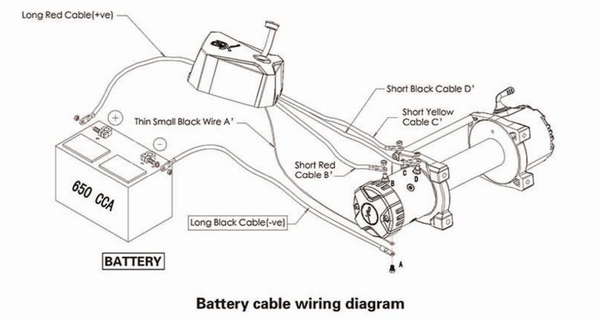
Use this diagram for hooking up the large cables of your winch.
The next diagram can be used for troubleshooting the XRC's electrical circuits.
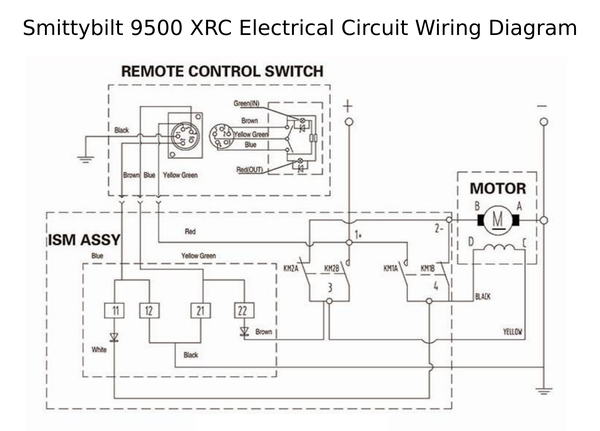
Use this wiring diagram for troubleshooting the winch electricals.
9500 XRC Replacement Parts
This is the correct 5-pin wired winch remote control for Smittybilt XRC winches.
Frankly, these winches don't really have the wide parts availability like Warn winches. You can get replacement parts, but it's a little harder to find specific things. Here are a few of the common parts you might need to replace:
Smittybilt 9500 XRC vs Warn M8000
The synthetic winch rope version is lighter, safer, and has a much stronger winch line than the steel winch cable version.
The Warn M8000 winch (aka the M8) looks somewhat similar to the XRC
9500, but has some important differences. If you're buying a winch for a
Jeep, the M8000 is right in the weight range that you want to be looking at.
First,
the M8000 is made in the USA and the XRC is made in China. While China
used to have a terrible reputation for quality, most of us know that
lots of high quality goods come out of China, such as the iPhone. The
XRC is probably middle of the road on the quality scale, but not like
the Warn.
Second, the M8000 winch has a seriously reliable
design that has been around for decades. If you can find an M8000 for
cheap and clean it up, it'll run forever.
We would not expect this with the Smittybilt.
From what we're seeing the 9500 XRC just doesn't hold up to repeated off road use for years and years. The Warn simply has better fit and finish and better internals. Typically XRCs are lasting 3-5 years under hard use before something major fails.
This is a reliable, inexpensive winch that comes with 100' of steel winch cable, a roller fairlead, a wired winch controller, and a contactor pack.
Both the M8000 and the XRC 9500 come with either synthetic winch rope or steel winch cable. They both have wired remotes and essentially come with the same parts, i.e. remote, fairlead, cable, wiring, etc.
The M8000 was recently updated with a contactor pack. This is a replacement for the old-style solenoid packs that the XRC still uses.
Contactors are the wave of the future: they generate less heat, are more reliable, and are waterproof.
What about water?
The M8000 doesn't have a waterproof rating, but you can probably wager that between the two it's probably a wash as to which is better. The IP67 rating on the XRC isn't that great and we think the better build quality of the Warn probably means it can take some water.
Lastly:
The Warn M8000 winch isn't that much more expensive than the XRC. If you need a budget winch and you can swing a little more coin, we'd definitely pick the M8000 over the XRC.
Smittybilt 9500 XRC vs Warn 9.5 XP
The XP comes with either steel winch cable or synthetic winch rope. The best part about it? Warn's legendary reliability.
Right now, you're asking:
Why would you even compare these two?
And you're right! The Warn 9.5 XP is insanely expensive compared to the 9500 XRC. In fact, you'll probably spend about 5 times more on an XP than an XRC.
But like the M8000, it doesn't really come down to features. It comes down to build quality and long-term reliability.
Here are the specs that are similar for these two winches:
This is just like the steel cable XP, but with synthetic winch line and an aluminum hawse fairlead.
How are they different?
Here's the deal:
One
thing we always like to look at is weight. It has a direct effect on
reliability in winches. The Warn 9.5 XP weighs 87 lbs and the 9500 XRC
weighs 78 lbs.
This is a huge difference!
Keep in mind that the winch controllers, fairleads, and winch cables will have similar weights. (It's not like winch cables are that different.)
So where is the extra weight coming from in the XP: all the internal parts and external casings. Parts are thicker and heavier. This is the difference between a light-duty winch and a heavy-duty winch.
All that said, if you're still here, you're probably not looking to take your new Smittybilt XRC 9500 on a round-the-world trip or an epic solo journey through the Rockies, so the bullproof reliability of the Warn might not be as useful to you.
Smittybilt 9500 XRC vs Smittybilt X20
The 10k X20 comes with either synthetic winch rope or steel cable. It's got an IP68 waterproof rating and comes with a wireless remote.
Need a better version of the XRC, but still pretty cheap?
The Smittybilt X20 is very similar to the Smittybilt XRC, but is basically an upgraded version. Most of the specs are the same, so we'll point out the differences.
To start, it has the next-level-up waterproof rating: IP68. IP68 means it's protected when submerged over 1 meter in depth, but also specifies that water may enter as long as it doesn't do harm.
Practically speaking, we think this is a good thing and should mean that you don't need to dry out your X20 winch after dunking it. With a normal winch, you should run it in freespool to heat up the drum and dry out the insides.
Next, the X20 has an integrated wireless winch remote. The remote is a large pistol grip, like the wired XRC remote.
This is just like the steel cable version of the X20, but has a synthetic winch rope and aluminum hawse fairlead.
The X20 also has a dynamic braking system. The biggest benefit of this
is that it reduces drum temperatures by up to 66% - low drum
temperatures are a lot better for synthetic winch lines. Frankly, if
you're going to run synthetic, you should consider this winch so that
your winch line lasts when you're on the trail.
The X20 is slightly more expensive than the XRC. If you drive through a lot of water and mud and you run synthetic line, this is a better choice than the 9500 XRC.
Last updated: September 5, 2019
